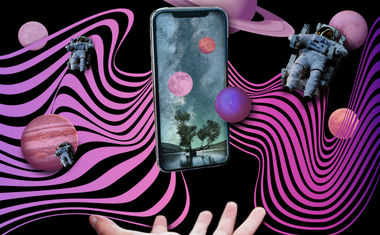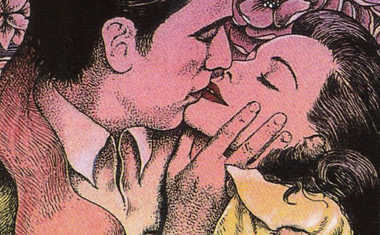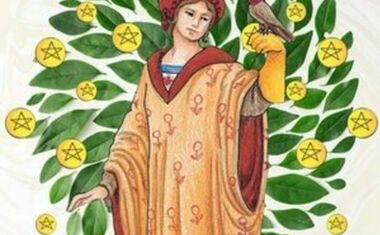
Ramon Llull
Discover the world's first magician
Ramon Llull
Perhaps it would be well to step back from the generalities and abstractions about magic and consider an individual 'magician'. In the 15th century, Ramon Llull (1232 - ~1316) was considered one of the greatest minds of the late middle ages. His magical thought and alchemy influenced Agrippa and Bruno (Yates 1982) and this influence was still alive in the 19th century (Levi 1860).
Today it is clear that the alchemical works attributed to Llull were not written by him (Waite 1922, Thorndike 1934). The spurious magical works, discussing alchemy and the curative properties of gems (Evans 1922), began appearing soon after his death and eventually more than 100 magical treatises were published (Bonner 1993). In the 15th century the legend of his magical prowess was broadly believed (Bonner 1993).
In point of fact, Llull was a profound Christian mystic (Vega 2002). His mysticism was completely orthodox and he remained loyal to the Roman Church and its doctrines (Carrigan 1999). He spent his life teaching what he believed to be a divinely inspired method, an "Art", to covert Moslems and Jews to the true faith. Late in his life he may have become a Franciscan tertiary (Bonner 1993).
A dedicated missionary, still venerated as "Blessed Ramon Llull" by the Franciscans and the Catholics of Majorca, came to be thought of as a "Magus" and was accused of heresy. In understanding this transformation, perhaps we will better understand the ambiguity associated with Magic in the 15th century. Along the way we may also find that the "Art" of Llull influenced the culture in which the Tarot was devised, and possibly even the designers who were immersed in that culture.
Llull's Life
The life of Blessed Ramon is documented, but the documentation must be classified as hagiography. Hagiography (i.e., lives of saints) characteristically is tainted by legend and pious myth designed to inspire, rather than faithfully relay history. But, with that caveat, his life provides a convenient introduction.
He was born into a wealthy family on Majorca, an island off the Mediterranean coast of what is now Spain but was then Aragon and Catalonia. His youth was spent as a courtier and his poetry shows a strong tie to the troubadours. Indeed, he is the author of one of the earliest romances, though his intent is pious and mystical rather than romantic. Place (2004) shows that this work outlines the same mystical path developed in the Tarot.
Following a series of visions, Ramon was converted from his "impious" ways and adopted the Franciscan ideal, giving away his wealth and becoming an itinerant preacher. Of course, he "set aside some money" for his abandoned wife and children -- a fact that might have endeared him to the Roman Curia that was considering his canonization but is unlikely to win him any points in family court today!
While living as a hermit he received a Divine revelation. The revelation consisted of a logic or art that could provide true answers to any question. Ramon spent the rest of his life teaching this method and using the method to try to convert Jews and Moslems. His "Ars Magna" is probably the Middle Ages' most ambitious attempt at synthesizing the Christian Neoplatonic understanding of creation (Johnston 1996). Current scholarship indicates that he wrote at least 256 works (Hames 2000).
The Art
The Art went through a number of revisions and simplifications during his lifetime (Hames 2000). These revisions should not be thought of as improvements or developments since Llull thought of the original revelation as the Ars Magna (Hames 2000). Rather, the complexity of the original system was reduced to make it easier to comprehend and communicate. As we will see, the simplifications also adapted the Art to Llull's mission to convert Jews and Moslems.
The original Art first expounds seven figures: A,S,T,V,X,Y,Z and then applies each to six others: R,E,I,N,C,G (Peers 1929). The first figure, for example, is a circle with A at the center representing the Godhead and 16 pie-slices dividing the circle into the primary attributes of the Godhead. The figures immediately bring to mind the complex "Figurae" of Joachim of Fiore (Reeves and Hirsch-Reich 1972) though there is nothing to indicate that Llull knew of Joachim or his prophesies at the time of Llull's revelation.
The Art itself involves a type of artificial intelligence in which elements of the figures are combined to form syllogisms that prove any true proposition. Thus, the Art is not a form of letter magic though it was taken to be such in later centuries (Yates 1982). Rather, the Art is a form of logic that could provide answers to specific questions. The method is based on the general Neoplatonic tradition and on the mystical version of Neoplatonism represented by Eriugena (Yates 1982). In other words, the figures are taken to be a true symbolic picture of the natural and supernatural cosmos and therefore encompass all knowledge accessible to human reason. The Neoplatonic and Neopythagorean core of Llull's system can be seen, for example in the order in which Llull presents the virtues: justice is highest, then fortitude and then temperance as the lowest (Bonner 1993). This is the same order as followed in the Type B ordering of the early Tarot (Dummett 1980).
A major revision of Llull's system, the Ars demonstrativa was written about 1283 at Montpellier (Peers 1929). In the revised system, the letters were written on concentric metal circles that could be rotated. This made it easier to see that all possible combinations of the components of the Neoplatonic worldview could be achieved and that each combination represented a different aspect of the truth. But even in this simplified arrangement, exactly which combination would answer a specific question and how to interpret the resulting combination still required considerable background study and remains, for the present author, totally opaque.
Perhaps the most interesting aspect of the Ars demonstrativa is that it makes clear that the letters are only symbols or mnemonic devises. Each letter is an abbreviation for the Neoplatonic principle it represents. Thus, the close ties between the Llullian art and the Art of Memory are made clear (Rossi 1983). In the 15th century, mnemonic devises had become a mystical and magical tool. Once again, we see the Llullian Art being associated with magic in the Renaissance mind.
The final version of the Art, the Ars Brevis, is another simplification and results in more comprehensible system. As a result, it is the version most frequently explained in the literature. It is also the version specifically designed to facilitate Llull's zeal to communicate with Jews and Moslems.
In the Ars Brevis there are only nine letters or Divine dignities: BCDEFGHIK plus A to represent the coincidence of the nine attributes in the Godhead (Johnston 1996). He uses the word "dignity" because this is the word used for the Divine attributes in Islamic theology. He uses the Neoplatonic nine as the basis of the system to appeal to both Neoplatonic Moslems and QBLHists. The number nine + one for the Godhead is a deliberate and conscious attempt to connect with the 10 sephiroth of the QBLHists.
Llull and Islam:
Ramon Llull was obsessed with the mission of converting the "saracens". He spent nine years studying Arabic and a number of his works were originally written in Arabic and only subsequently translated into Latin. He studied and respected the Islamic philosophers such as Al-Ghazali (Yates 1982) and was naturally attracted to the Neoplatonic mysticism of the Sufi (Hames 2000). His Ars Brevis was designed to find the fundamental unity underlying Islam and Christianity.
Llull was respectful of Islamic thought and Sufi mysticism in order that dialogue could take place (Peers 1929). So if modern Tarotists are correct in seeing Sufi influences on the Tarot then that influence may have come through the Christian Neoplatonic system of Llull. But while he was respectful, it would be erroneous to think that Llull was influenced by Islamic thought or assimilated the best of Islamic mysticism into his system (Peers 1929). Llull thought that Islam was an atrocity that needed to be eliminated. He vigorously preached to Popes and Kings in order to instigate a new crusade. He was quite antagonistic to the infidels (Bonner 1993). In later life, Ramon lamented that the saracens were unable to understand the falseness of their religion as proven by his Art. He made several trips to North Africa where he was mobbed, imprisoned and exiled (Hillgarth 1971).
Llull and QBLH
Llull does not appear to have invested the same amount of energy into converting the Jews. Apparently, he saw Judaism as less of a threat to Christianity. He studied Hebrew but was not fluent as he was in Arabic. Nevertheless, his writings make it clear that he was familiar with the Sefer Yetzirah and the Neoplatonic system of the sephiroth (Hames 2000).
As with Islam, Llull was respectful of the QBLHists. His approach is to educate through his Art, not to shame or insult. But, once again, the motive is not that he feels that the QBLHists have the truth. In fact, he composed 52 sermons against the errors of the Jews (Johnston 1996). Llull was trying to convince the QBLHists that they don't understand the correspondence between their faith and its fulfillment in Christianity. This is very much the same approach taken by later Christian Cabalists, such as Pico della Mirandola, who attempted to show the compatibility of QBLH and Christianity. What has become clear through modern scholarship (Hames 2000) is that Pico did not begin the Christian Cabala. That distinction belongs to Ramon Lull.
The 10 sephiroth of QBLH play the same role in Judaism as the 9+1 dignities of Llull's Art. The similarities are not surprising since both are based on the emanations of Plotinus. So while it can be said that Llull was influenced by QBLHist thought, it is probably more insightful to point out that both are based on Neoplatonism.
It is interesting to note that both QBLH and Llull's Art use the tree as an illustrative analogy (Hames 2000). Again it is not clear who influenced whom. It may be that Llull adopted the tree from earlier Jewish writings or it may be that the rabbis adopted the tree in order to use Llull's own illustrations against him. It is certainly clear that Llull influenced the QBLHists since some groups began to use Llull's Ars Brevis in their own mystical exercises (Hames 2000).
Perhaps the most significant consequence of Llull's interaction with the QBLHists is that the rabbis took the threat of his Art very seriously (Hames 2000). The Church had required a number of previous debates between rabbis and Friars but they usually ended in stalemates. Both sides based their arguments on scriptural citations and each side simply asserted its own interpretation of the texts. This was true even of Llull's predecessor Ramon Marti, author of "Pugio fedei". Marti had a very broad knowledge of Hebrew texts and cited them in Hebrew with Latin translations. Still, the rabbis could offer reasonable alternative interpretations.
Llull's approach differed in that he based his arguments on the mystical doctrine of QBLH and was, therefore, using the Jews' own interpretations against them. This made Llull far more dangerous and less easily dismissed. The result was that some of the most important rabbis of the time wrote responses and wrote them in the terminology and context of the secret QBLH. The writings particularly of Solomon ibn Adret began to clearly define and publish QBLH doctrines (Hames 2000). So details of the QBLH, previous transmitted orally and in secret, began to be published and became available to a Christian audience a century or more before the 15/16th century Christian Cabalists.
Transmission of his ideas
Given what we have seen of Ramon Llull and his Art, he might seem a reasonable candidate for the designer of the Tarot. But he was in the wrong place at the wrong time. He died a century before the Tarot appeared. Although he visited Italy on several occasions, it was never his home base.
For his ideas to have influenced the Tarot designers, it would be necessary to establish that his ideas did not die with him and were available in northern Italy in the first half of the 15th century. Fortunately, the details of the transmission are well established.
The continuance of Llull's ideas occurred primarily through the University of Paris were he visited and/or taught on four occasions (1287-9, 1297-9, 1306, 1309-1311). One of his students, Thomas Le Myesier (d. 1336), continued to teach the Llullian Art at Paris and compiled and published his writings (Hillgarth 1971). As we will see below, we know that the Art continued to be taught in Paris until at least 1390.
We also know that Pier Leoni, physician to the Medici in Florence by 1475, had studied in Paris and arrived in Italy with Llullian works compiled by Le Myesier (Hillgarth 1971). Pier Leoni was an interesting character who was expelled from both Venice and Padua apparently for practicing magic (Hillgarth 1971). So it is little wonder that Llullism and magic were commonly associated in the Italian Renaissance.
A second line of transmission into Italy occurred through the Neoplatonist Nicholas of Cusa. Cusa's library contained 68 volumes of Llull's works (Hillgarth 1971) and one of Llull's sermons appears in a notebook of Cusa (Johnston 1996). Cusa's teacher at Paris was Heimeric van de Velde whose writings show the influence of Llull as early as 1425 (Hillgarth 1971). Cusa also studied with the Llullian circle in Padua which had been founded by teachers from Barcelona. On a number of occasions, Cusa traveled to the Carthusian monastery at Chartreuse where many of Llull's works were preserved and likely obtained his copies there.
A third line of transmission occurred through the Spiritual Franciscans who traveled broadly in Italy. Several influential Spirituals incorporated Llull's ideas into their popular writings (Hillgarth 1971) where they were blended with mysticism and Joachite apocalyticism.
So Llull's Art was alive and well in 15th century Italy and even being taught in Padua. In some cases, such as Pier Leoni, the Art was associated with magic. In other cases, such as the Franciscan fraticelli, it was associated with a radical apocalyticism. In yet other cases, such as Nicholas of Cusa, it was the mystical Neoplatonism that predominated. It seems certain that some mixture of these different versions of the Art were available and influential at the time the Tarot was designed.
Controversy after the death of Llull
The unusual nature of Llull's Art made him a controversial figure during his lifetime and that controversy continued after his death. His followers worked hard to preserve his writings and tried to get him canonized (Bonner 1993). Llull had a close relationship with the Spiritual Franciscans in Provence, often taught his Art in Montpellier, and probably attended the general chapter of Assisi in 1295 (Hillgarth 1971). Llull was never radical in his own apocalyptic doctrine, but the association with the Spirituals was considered suspicious.
The more enthusiastic of his followers included the mystical circle of fraticelli of Valencia and the Carthusians at Chartreuse in Vauvert. Lull's concepts also became associated with the mystical "devotion moderna" of Ruysbroeck (Hillgarth 1971). The enthusiasm and rationalism of Lull's followers attracted the attention of the Inquisition and a list of errors was published (Bonner 1993). His principal opponent was the inquisitor Nicolau Eymerich. In 1376, Eymerich obtained a papal bull prohibiting the teaching of Llullism and condemning 20 of Llull's books. Later, Eymerich was discredited and the authenticity of the papal bull was questioned. In 1419 the Church officially declared the bull to be spurious (Peers 1929).
A second condemnation by the theology faculty at Paris was instigated by Jean Gerson in 1390 and teaching of the Llullian Art was prohibited in Paris (Hillgarth 1971). This condemnation is interesting because it suggests that the Llullian Art was still being taught at Paris at the end of the 14th century, otherwise Gerson would not have bothered with the condemnation (Bonner 1993).
The orthodoxy of Ramon Llull was finally settled in 1563 when the Council of Trent declared his works to be orthodox and lifted all previous prohibitions (Peers 1929). But the fact remains that during the 15th century, when the Tarot was designed, Llull was considered heterodox, if not heretical. The spurious alchemical works identified him as a Magus. Association with the Spiritual Franciscans identified him with the apocalypticism we see in the Tarot (Betts 1998). His Neoplatonism endeared him to the 15th century intellectual and can be seen in the mystical hierarchy of the "Fool's Journey" in the Tarot. His mnemonic Art was related to mystical and magical connotations of the Art of Memory. His Art was acknowledged as a precursor of the magical and mystical Christian Cabala. His use of letters brought to mind the mystical letter magic of Abulafia (Hames 2000). His Art could be related to the Ars Notoria as another magical and mystical method for acquiring knowledge.
So was Ramon Llull a magician? It seems certain that he himself would have been repulsed by the idea. It also seems likely that the 15th century would have viewed him in precisely that way. Certainly Leoni, Agrippa, and Bruno saw him as magician (Yates 1982). Llull's Art is clearly orthodox and anything but magical. In the 15th century, the historical evidence makes it clear that Llull's Art was lumped by some into the category of Magic.



